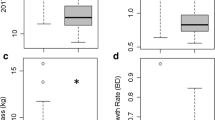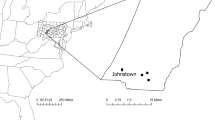Abstract
Cut-leaved teasel is an invasive weed in Missouri that reduces the diversification of native species along roadsides and impairs traffic visibility. Teasel is a biennial and grows as a rosette in the first year and flowers the second year. Reproduction is only by seed. Field studies were conducted in 2004 and 2005 at two locations to assess the seed production of cut-leaved teasel. From a natural stand, fifteen plants were tagged at the onset of flowering. Selected plants included those considered growing in a group and those growing alone; a plant was considered alone when no other plant was adjacent for at least 60 cm. Whenever a seedhead completed flowering, it was covered with a cellophane bag and harvested one month later. Linear regression was used to correlate the weight of seeds from a single seedhead and number of seeds to estimate the total seed production per seedhead. The number of seedheads per plant varied from 3 to 56. On average, plants growing alone had 64% more seedheads per plant than plants occurring in a group. Seed numbers in the primary seedhead ranged from 511 to 1,487. Total seed production per plant ranged from 1,309 to 33,527. Seed production was 61% greater for plants growing alone versus those growing in a group and was more prolific in 2005 than in 2004. In addition, seed production per plant varied between locations for plants growing alone, but seed yield per plant was similar for plants growing in groups. Colonization of teasel in new areas is facilitated by higher seedhead numbers per plant and total seed production compared to reproduction of plants in areas of intraspecific competition.
Similar content being viewed by others
References
Beaton L.L. & Dudley S.A. 2004. Tolerance to salinity and manganese in three common roadside species. Int. J. Plant Sci. 165: 37–51.
Bentivegna D. J. & R.J. Smeda. 2011. Cutleaf teasel (Dipsacus laciniatus L.): Seed development and persistence. Invasive Plant Sci. & Manage. 4: 31–37.
Bobrov E.G. 1957. Genus 1411. Dipsacus L., pp. 16–20. In: Shihkin B.K. & Bobrov E.G. (eds), Flora of the USSR, Vol XXIV, Izdatel’stvo Akademii Nauk SSSR, Moskva, Leningrad. (Transl. from Russian.) Israel Prog for SCI. Transl., Jerusalem.
Caswell H. & Werner P.A. 1978. Transient behavior and life history analysis of teasel (Dipsacus sylvestris Huds.). Ecology 59: 53–66.
Cheesman O.D. 1998. The impact of some field boundary management practices on the development of Dipsacus fullonum L. flowering stems, and implication for conservation. Agr. Ecosyst. Environ. 68: 41–49.
Chujo H. & Hanyu Y. 1990. Growth characteristics of teasel (Dipsacus fullonum L.). Jap. J. Crop Sci. 59: 461–468.
Glass W.D. 1991. Vegetation management guideline: cut-leaved teasel (Dipsacus laciniatus L.) and common teasel (Dipsacus sylvestris Huds.). Nat. Area J. 11: 213–214.
Hedberg I. & Hedberg O. 1977. The genus Dipsacus in tropical Africa. Botaniska notiser 129: 383–389.
Hoffman R. & Kearns K. 1997. Wisconsin Manual of Control. Recommendation for ecologically invasive plants. Wisconsin Department of natural Resources, Madison, WI. 102 pp.
Huenneke L.F. & Thomson J.K. 1994. Potential interference between a threatened endemic thistle and an invasive nonnative plant. Conserv. Biol. 9: 416–425.
Jurica H.S. 1921. Development of head and flower of Dipsacus sylvestris. Bot. Gazette 71:138–145.
Lacey J.R., Marlow C.B. & Lane J.R. 1989. Influence of spotted knapweed (Centaurea maculosa) on surface runoff and sediment yield. Weed Technol. 3: 627–631.
Mullins D. 1951. Teasel growing, an ancient practice. World Crops 3: 146–147.
Neubert M.G. & Caswell H. 2000. Demography and dispersal: calculation and sensitivity of invasion speed for structured population. Ecology 81: 1613–1628.
Rector B.G., Harizanova V., Sforza R., Widmer T. & Wiedenmann R.N. 2006. Prospects for biological control of teasels, Dipsacus spp., a new target in the United States. Biol. Control 36: 1–14.
Roberts H.A. 1986. Seed persistence in soil and seasonal emergence in plant species from different habits. J. Appl. Ecol. 23: 639–656.
Rodale R. 1984. Teasel in Our Lawn. Organic Gardening 31(11): 22–25.
SAS (Statistical Analysis Systems) 2003. SAS/STAT User’s Guide. Release 9.1 Software version 8e. Cary, NC: Statistical. Analysis Systems Institute.
Solecki M.K. 1993. Cut-leaved and common teasel (Dipsacus laciniatus L. and D. sylvestris Huds): profile of two invasive aliens, pp 85–92. In: McKnight B.N. (ed.), Biological Pollution: The control and impact of invasive exotic species, Indiana Academic of Science, Indianapolis.
USDA 2006. The PLANT Database, Version 3.5 (http://plants.usda.gov). National Plant Data Center. Baton Rouge, LA 70874-4490 USA. Access January 20, 2006.
Werner P.A. 1975a. A seed trap for determining patterns of seed deposition in terrestrial plant. Can. J. Bot. 53: 810–813.
Werner P.A. 1975b. The biology of Canadian weeds 12. Dipsacus sylvestris Huds. Can. J. Plant Sci. 55: 783–794.
Werner P.A. 1977. Colonization success of a “Biennial” plant species: experimental field studies of species cohabitation and replacement. Ecology 58: 840–849.
Author information
Authors and Affiliations
Corresponding author
Rights and permissions
About this article
Cite this article
Bentivegna, D.J., Smeda, R.J. Seed production of cut-leaved teasel (Dipsacus laciniatus) in central Missouri. Biologia 66, 807–812 (2011). https://doi.org/10.2478/s11756-011-0078-2
Received:
Accepted:
Published:
Issue Date:
DOI: https://doi.org/10.2478/s11756-011-0078-2




